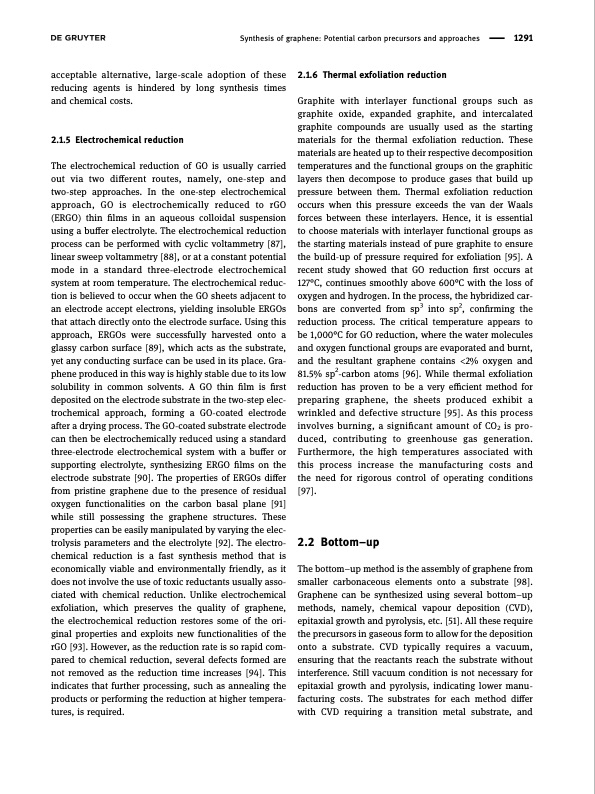
PDF Publication Title:
Text from PDF Page: 008
Synthesis of graphene: Potential carbon precursors and approaches 1291 acceptable alternative, large-scale adoption of these reducing agents is hindered by long synthesis times and chemical costs. 2.1.5 Electrochemical reduction The electrochemical reduction of GO is usually carried out via two different routes, namely, one-step and two-step approaches. In the one-step electrochemical approach, GO is electrochemically reduced to rGO (ERGO) thin films in an aqueous colloidal suspension using a buffer electrolyte. The electrochemical reduction process can be performed with cyclic voltammetry [87], linear sweep voltammetry [88], or at a constant potential mode in a standard three-electrode electrochemical system at room temperature. The electrochemical reduc- tion is believed to occur when the GO sheets adjacent to an electrode accept electrons, yielding insoluble ERGOs that attach directly onto the electrode surface. Using this approach, ERGOs were successfully harvested onto a glassy carbon surface [89], which acts as the substrate, yet any conducting surface can be used in its place. Gra- phene produced in this way is highly stable due to its low solubility in common solvents. A GO thin film is first deposited on the electrode substrate in the two-step elec- trochemical approach, forming a GO-coated electrode after a drying process. The GO-coated substrate electrode can then be electrochemically reduced using a standard three-electrode electrochemical system with a buffer or supporting electrolyte, synthesizing ERGO films on the electrode substrate [90]. The properties of ERGOs differ from pristine graphene due to the presence of residual oxygen functionalities on the carbon basal plane [91] while still possessing the graphene structures. These properties can be easily manipulated by varying the elec- trolysis parameters and the electrolyte [92]. The electro- chemical reduction is a fast synthesis method that is economically viable and environmentally friendly, as it does not involve the use of toxic reductants usually asso- ciated with chemical reduction. Unlike electrochemical exfoliation, which preserves the quality of graphene, the electrochemical reduction restores some of the ori- ginal properties and exploits new functionalities of the rGO [93]. However, as the reduction rate is so rapid com- pared to chemical reduction, several defects formed are not removed as the reduction time increases [94]. This indicates that further processing, such as annealing the products or performing the reduction at higher tempera- tures, is required. 2.1.6 Thermal exfoliation reduction Graphite with interlayer functional groups such as graphite oxide, expanded graphite, and intercalated graphite compounds are usually used as the starting materials for the thermal exfoliation reduction. These materials are heated up to their respective decomposition temperatures and the functional groups on the graphitic layers then decompose to produce gases that build up pressure between them. Thermal exfoliation reduction occurs when this pressure exceeds the van der Waals forces between these interlayers. Hence, it is essential to choose materials with interlayer functional groups as the starting materials instead of pure graphite to ensure the build-up of pressure required for exfoliation [95]. A recent study showed that GO reduction first occurs at 127°C, continues smoothly above 600°C with the loss of oxygen and hydrogen. In the process, the hybridized car- bons are converted from sp3 into sp2, confirming the reduction process. The critical temperature appears to be 1,000°C for GO reduction, where the water molecules and oxygen functional groups are evaporated and burnt, and the resultant graphene contains <2% oxygen and 81.5% sp2-carbon atoms [96]. While thermal exfoliation reduction has proven to be a very efficient method for preparing graphene, the sheets produced exhibit a wrinkled and defective structure [95]. As this process involves burning, a significant amount of CO2 is pro- duced, contributing to greenhouse gas generation. Furthermore, the high temperatures associated with this process increase the manufacturing costs and the need for rigorous control of operating conditions [97]. 2.2 Bottom–up The bottom–up method is the assembly of graphene from smaller carbonaceous elements onto a substrate [98]. Graphene can be synthesized using several bottom–up methods, namely, chemical vapour deposition (CVD), epitaxial growth and pyrolysis, etc. [51]. All these require the precursors in gaseous form to allow for the deposition onto a substrate. CVD typically requires a vacuum, ensuring that the reactants reach the substrate without interference. Still vacuum condition is not necessary for epitaxial growth and pyrolysis, indicating lower manu- facturing costs. The substrates for each method differ with CVD requiring a transition metal substrate, andPDF Image | Synthesis of graphene Potential carbon precursors

PDF Search Title:
Synthesis of graphene Potential carbon precursorsOriginal File Name Searched:
10-1515-ntrev-2020-0100.pdfDIY PDF Search: Google It | Yahoo | Bing
Salgenx Redox Flow Battery Technology: Power up your energy storage game with Salgenx Salt Water Battery. With its advanced technology, the flow battery provides reliable, scalable, and sustainable energy storage for utility-scale projects. Upgrade to a Salgenx flow battery today and take control of your energy future.
| CONTACT TEL: 608-238-6001 Email: greg@infinityturbine.com | RSS | AMP |